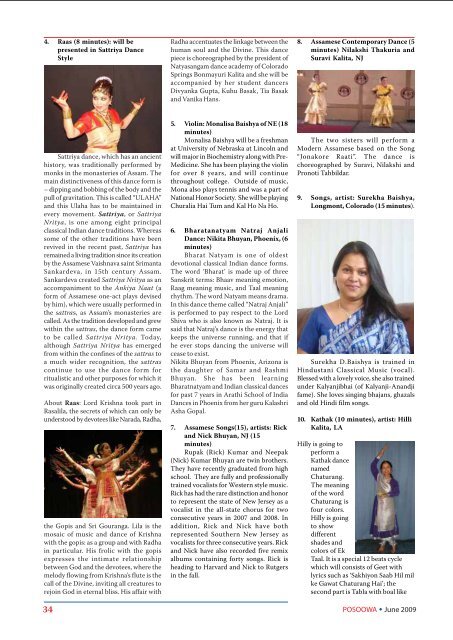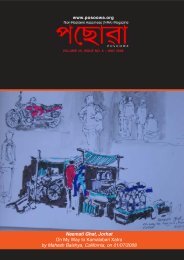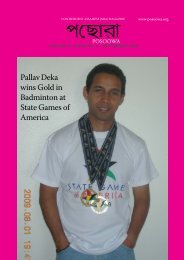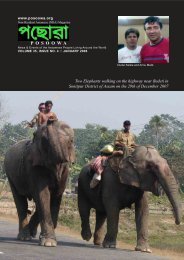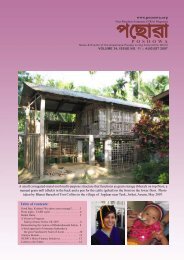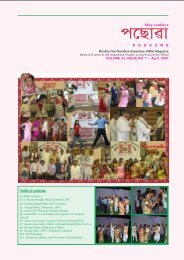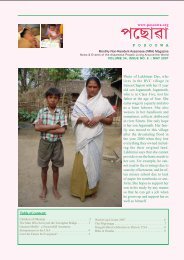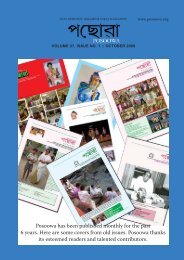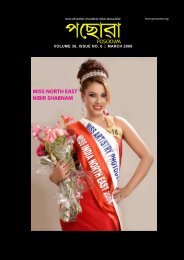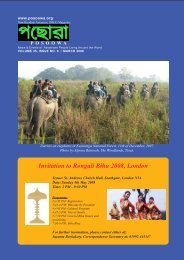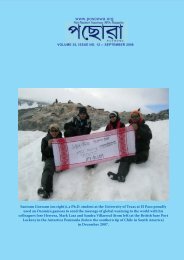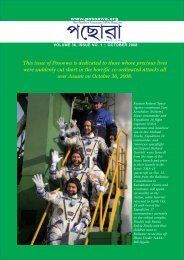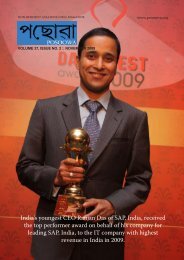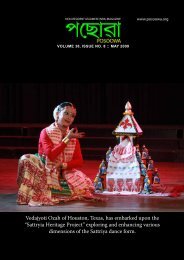Assam 2009 - Posoowa
Assam 2009 - Posoowa
Assam 2009 - Posoowa
- No tags were found...
You also want an ePaper? Increase the reach of your titles
YUMPU automatically turns print PDFs into web optimized ePapers that Google loves.
4. Raas (8 minutes): will be<br />
presented in Sattriya Dance<br />
Style<br />
Radha accentuates the linkage between the<br />
human soul and the Divine. This dance<br />
piece is choreographed by the president of<br />
Natyasangam dance academy of Colorado<br />
Springs Bonmayuri Kalita and she will be<br />
accompanied by her student dancers<br />
Divyanka Gupta, Kuhu Basak, Tia Basak<br />
and Vanika Hans.<br />
8. <strong>Assam</strong>ese Contemporary Dance (5<br />
minutes) Nilakshi Thakuria and<br />
Suravi Kalita, NJ<br />
Sattriya dance, which has an ancient<br />
history, was traditionally performed by<br />
monks in the monasteries of <strong>Assam</strong>. The<br />
main distinctiveness of this dance form is<br />
– dipping and bobbing of the body and the<br />
pull of gravitation. This is called “ULAHA”<br />
and this Ulaha has to be maintained in<br />
every movement. Sattriya, or Sattriya<br />
Nritya, is one among eight principal<br />
classical Indian dance traditions. Whereas<br />
some of the other traditions have been<br />
revived in the recent past, Sattriya has<br />
remained a living tradition since its creation<br />
by the <strong>Assam</strong>ese Vaishnava saint Srimanta<br />
Sankardeva, in 15th century <strong>Assam</strong>.<br />
Sankardeva created Sattriya Nritya as an<br />
accompaniment to the Ankiya Naat (a<br />
form of <strong>Assam</strong>ese one-act plays devised<br />
by him), which were usually performed in<br />
the sattras, as <strong>Assam</strong>’s monasteries are<br />
called. As the tradition developed and grew<br />
within the sattras, the dance form came<br />
to be called Sattriya Nritya. Today,<br />
although Sattriya Nritya has emerged<br />
from within the confines of the sattras to<br />
a much wider recognition, the sattras<br />
continue to use the dance form for<br />
ritualistic and other purposes for which it<br />
was originally created circa 500 years ago.<br />
About Raas: Lord Krishna took part in<br />
Rasalila, the secrets of which can only be<br />
understood by devotees like Narada, Radha,<br />
the Gopis and Sri Gouranga. Lila is the<br />
mosaic of music and dance of Krishna<br />
with the gopis: as a group and with Radha<br />
in particular. His frolic with the gopis<br />
expresses the intimate relationship<br />
between God and the devotees, where the<br />
melody flowing from Krishna’s flute is the<br />
call of the Divine, inviting all creatures to<br />
rejoin God in eternal bliss. His affair with<br />
34<br />
5. Violin: Monalisa Baishya of NE (18<br />
minutes)<br />
Monalisa Baishya will be a freshman<br />
at University of Nebraska at Lincoln and<br />
will major in Biochemistry along with Pre-<br />
Medicine. She has been playing the violin<br />
for over 8 years, and will continue<br />
throughout college. Outside of music,<br />
Mona also plays tennis and was a part of<br />
National Honor Society. She will be playing<br />
Churalia Hai Tum and Kal Ho Na Ho.<br />
6. Bharatanatyam Natraj Anjali<br />
Dance: Nikita Bhuyan, Phoenix, (6<br />
minutes)<br />
Bharat Natyam is one of oldest<br />
devotional classical Indian dance forms.<br />
The word ‘Bharat’ is made up of three<br />
Sanskrit terms: Bhaav meaning emotion,<br />
Raag meaning music, and Taal meaning<br />
rhythm. The word Natyam means drama.<br />
In this dance theme called “Natraj Anjali”<br />
is performed to pay respect to the Lord<br />
Shiva who is also known as Natraj. It is<br />
said that Natraj’s dance is the energy that<br />
keeps the universe running, and that if<br />
he ever stops dancing the universe will<br />
cease to exist.<br />
Nikita Bhuyan from Phoenix, Arizona is<br />
the daughter of Samar and Rashmi<br />
Bhuyan. She has been learning<br />
Bharatnatyam and Indian classical dances<br />
for past 7 years in Arathi School of India<br />
Dances in Phoenix from her guru Kalashri<br />
Asha Gopal.<br />
7. <strong>Assam</strong>ese Songs(15), artists: Rick<br />
and Nick Bhuyan, NJ (15<br />
minutes)<br />
Rupak (Rick) Kumar and Neepak<br />
(Nick) Kumar Bhuyan are twin brothers.<br />
They have recently graduated from high<br />
school. They are fully and professionally<br />
trained vocalists for Western style music.<br />
Rick has had the rare distinction and honor<br />
to represent the state of New Jersey as a<br />
vocalist in the all-state chorus for two<br />
consecutive years in 2007 and 2008. In<br />
addition, Rick and Nick have both<br />
represented Southern New Jersey as<br />
vocalists for three consecutive years. Rick<br />
and Nick have also recorded five remix<br />
albums containing forty songs. Rick is<br />
heading to Harvard and Nick to Rutgers<br />
in the fall.<br />
The two sisters will perform a<br />
Modern <strong>Assam</strong>ese based on the Song<br />
“Jonakore Raati”. The dance is<br />
choreographed by Suravi, Nilakshi and<br />
Pronoti Tahbildar.<br />
9. Songs, artist: Surekha Baishya,<br />
Longmont, Colorado (15 minutes).<br />
Surekha D.Baishya is trained in<br />
Hindustani Classical Music (vocal).<br />
Blessed with a lovely voice, she also trained<br />
under Kalyanjibhai (of Kalyanji-Anandji<br />
fame). She loves singing bhajans, ghazals<br />
and old Hindi film songs.<br />
10. Kathak (10 minutes), artist: Hilli<br />
Kalita, LA<br />
Hilly is going to<br />
perform a<br />
Kathak dance<br />
named<br />
Chaturang.<br />
The meaning<br />
of the word<br />
Chaturang is<br />
four colors.<br />
Hilly is going<br />
to show<br />
different<br />
shades and<br />
colors of Ek<br />
Taal. It is a special 12 beats cycle<br />
which will consists of Geet with<br />
lyrics such as ‘Sakhiyon Saab Hil mil<br />
ke Gawat Chaturang Hai’; the<br />
second part is Tabla with boal like<br />
POSOOWA • June <strong>2009</strong>


